How to make your own Sourdough Starter, using simple ingredients with no special equipment, in just six days, that can be used in our sourdough bread. Video.
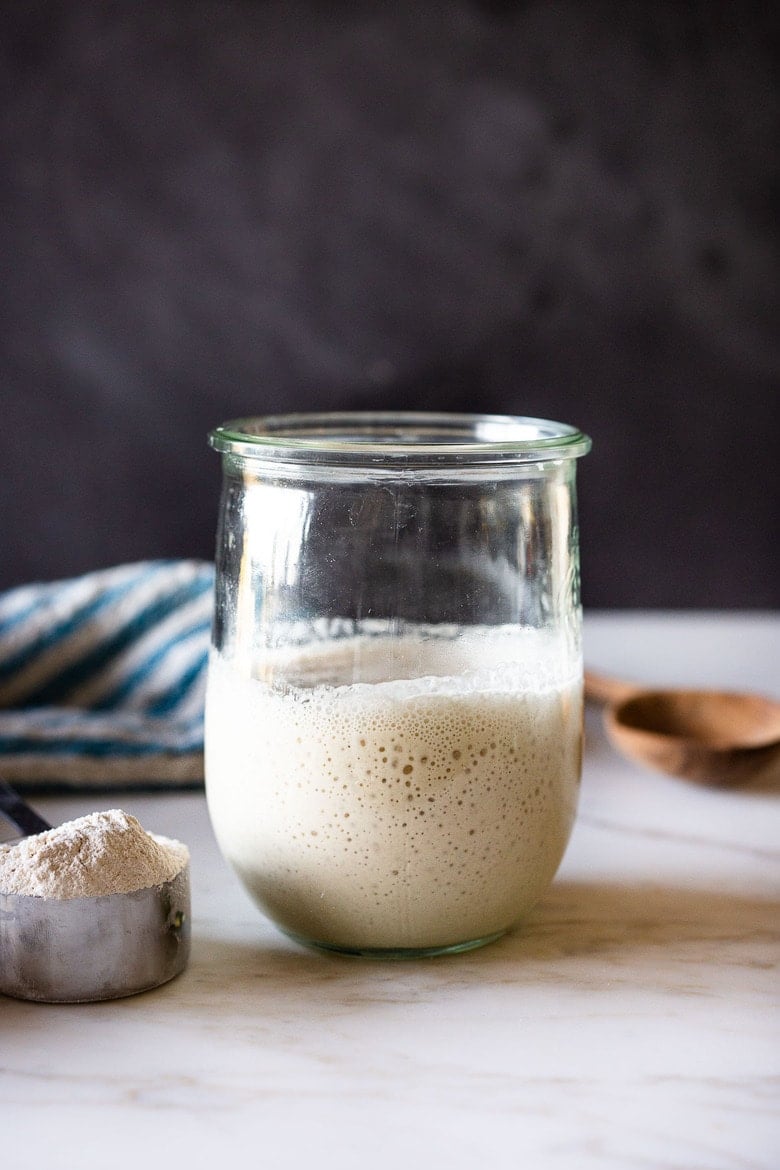
When you understand one thing through and through, you understand everything.~ Shunryu Suzuki
With over 500 five-star reviews and hundreds of success stories, my chef’s perfected sourdough starter guide has everything you need to make your own homemade starter. In just six days, you’ll be baking the most beautiful sourdough loaves!
But first, What is a starter?
Sourdough starter is a “wild yeast” made from flour, water, and the natural wild yeast in the air. With a little care and patience, it ferments, and when strong and active, just a little bit of starter replaces commercial yeast and makes your bread rise, while transforming the gluten in the bread into something more easily digestible. Store-bought yeast is not needed!
How to Make Sourdough Starter | 20-Min Video
***Don’t see the video? Allow 15-20 seconds to load it right here!*** (Still don’t see it? Check that your ad blocker is turned off; use Chrome for the best experience.)
Fast forward to Specific Day by video time (using scroll bar underneath video)
- Day 1 Morning: :23
- Day 2 Morning: 4:10
- Day 3 Morning: 7:00
- Day 3 Evening: 9:12
- Day 4 Morning: 11:50
- Day 4 Evening: 13:37
- Day 5 Morning: 14:45
- Day 6 Evening: 16:50
- Day 6 Morning: 18:12
- Day 6 Evening: 20:10
Sourdough Starter Recipe Ingredients
- Jar – A wide-mouth quart jar or a Weck’s 1-liter tulip jar.
- Flour – 5 lb bag of organic bread flour (plus 1 cup organic whole grain flour )
- Water – filtered water, tap water, or mineral water (specifically, San Pellegrino, for the correct mineral ratio). Distilled water does not have enough minerals.
- Scale – using a kitchen scale is optional but handy.
- Thermometer – Knowing the temp of the starter using a thermometer is optional but handy!
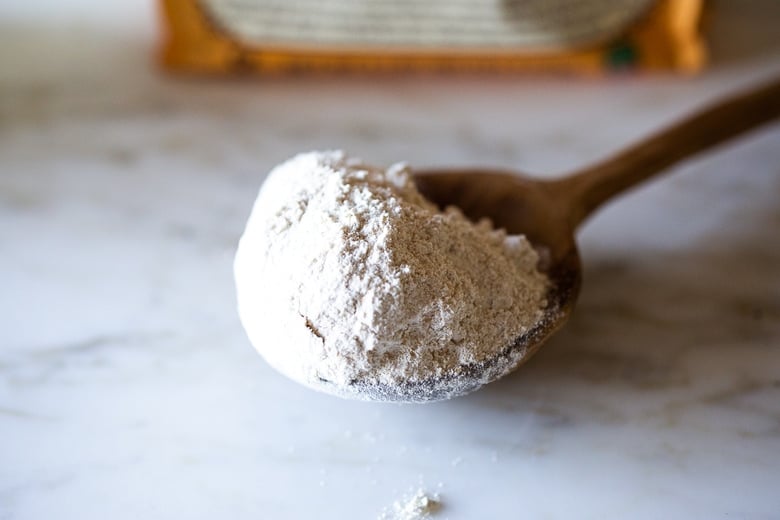
Understanding starter
- Think of sourdough starter as yeast. Only in this case, instead of buying a packet of yeast from the store, you are making your own living “wild yeast” by fermenting flour and water. Once it’s bubbly and happy, it is very much ike a very low-maintenance pet.
- You must feed it (stir in a mixture of flour and water) once a week to keep it active and strong. You know it’s happy when it bubbles. 😉 And YES, you can even name it.
- Some people believe that bread made with sourdough starter is actually better for you than bread made with yeast. Here and Here are a few articles to get you started on your own research. While I’m not sure if this is scientifically proven, I do know that bread made with sourdough starter, tastes infinitely better, feels easier to digest, and has more complexity and better texture, than bread made with commercial yeast. So if you are a bread lover- this is absolutely the way to go, as far as the quality of your finished bread.
How to Make Sourdough Starter
*See the recipe card for detailed instructions.
This recipe for Sourdough Starter takes 6 days (or up to 12 days if it is very cold where you live). For a primer, watch the 20-minute Sourdough Video above!
Day 1: Staring in the morning or at night, using a wide-mouth quart jar, tulip jar, or Crock or Glass Measuring Cup , mix 1 cup whole grain flour (120 grams) with 1/2 cup filtered water (120 grams) using a fork (or chopstick) making sure you’ve incorporated all the dry flour.
Place the lid lightly on top (using the Weck jar lid is really handy here) or a wet towel to keep moisture in, or plastic wrap- and let sit at room temperature (70-ish degrees) on the kitchen counter for 24-48 hours. If you are unsure how warm it is, use a kitchen thermometer and check it a few hours later. See notes for TEMPERATURE.
TIP #1: For your first measurement, weigh the flour using a kitchen scale so you can get an idea of how the mixture should feel. Do not weigh the measuring cup! It should be like a thick paste, like peanut butter. If you need to add a little more water to incorporate the flour, that is OK too!
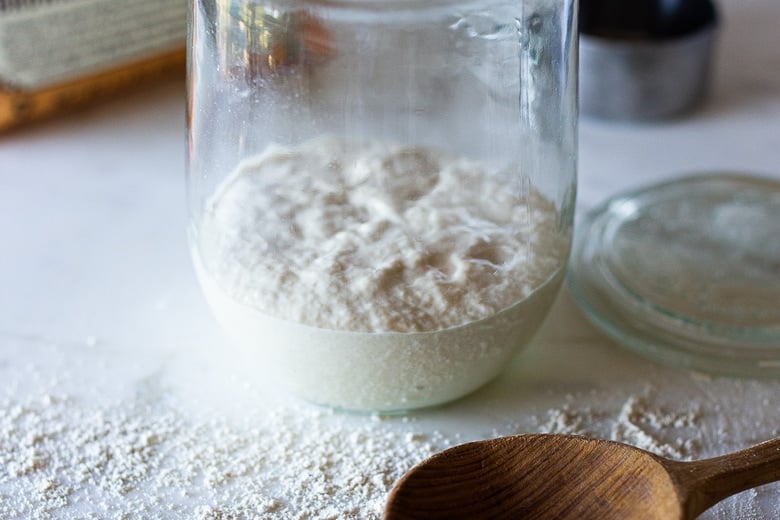
Day 2: After the first 24 hours, there may or may not be a bit of bubbling. Let the mixture rest until you see activity (bubbles or rising) sometimes this takes 36 hours or even 48 hours if very cold. When you see active bubbling, discard all but 1/2 cup of the starter (4 ounces).
To the remaining ½ cup of starter, stir in 1/2 cup water (120 grams), and mix well with a fork. Add 1 cup of organic bread flour (120 grams)spooned and leveled. Stir until combined. Again, it should feel like a thick paste. If overly dry, feel free to add a bit more water. Cover again and allow the mixture to sit at room temperature for another 24 hours.
Day 3: After 24 hours, hopefully, you will see some bubbling or rising and if not, let it go a bit longer until you see activity. Be patient.
Depending on how warm your house is and how active your starter, you may need to begin feeding more often or move to two feedings a day, in the morning and at night. If it is cold, one feeding a day may be enough.
TIP #2: Only feed the starter after it has peaked or looks hungry. See the “3 Signs of Hunger” below. Feeding it when it is “not hungry” will basically dilute all the growing yeast and make it lethargic. Better to underfeed than overfeed.
The 3 Signs of hunger
The photo below was taken after the starter was fed, and after it peaked (reached its highest), and now is sliding down. It is now “hungry” again. See the downward slide marks on the jar? Pay attention – your starter is telling you it is hungry.
- Look for “slide marks” (be sure to use a clean jar so you can see these clearly).
- Liquid at the top of the starter.
- Thin and runny. The starter is liquidy enough to pour out of the jar (when at room temp).

This might be 12 hours, it might be 14, it might be 18, or 24, depending on the temp in your house. In very warm climates, it may only be 6-8 hours. In winter, this may take 36 hours. It is better to underfeed rather than overfeed here.
For each feeding, discard all but 1/2 cup of the starter (keeping roughly ½-cup of starter in the jar). Add 1/2 cup water and 1 cup Bread Flour (spooned and leveled). Mix well, cover, and let this rest at room temperature for 12-24 hours or until the starter looks “hungry” again before repeating.
Day 4: Feed 1-2 times, discarding all but 1/2 cup of starter each time. Feed 1 cup bread flour, 1/2 cup water.
TIP #3: It is typical on day 4 for the starter to slow down and stall a bit. This is OK. Just keep going, be patient and look for the hunger signs, and only feed when clearly hungry. Hopefully, you’ll begin to see some rising and falling. It’s helpful to put the starter in a clean jar each day and mark the beginning level (with a sharpie, string or rubber band) so you can easily see this.
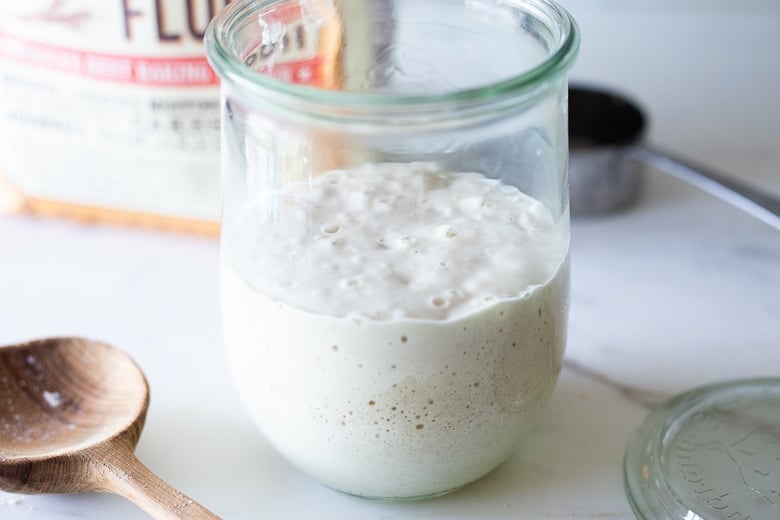
Above, you’ll see it peaking, and below, you’ll see it deflating and getting “hungry.” There may not be too much difference in the beginning, so look closely.
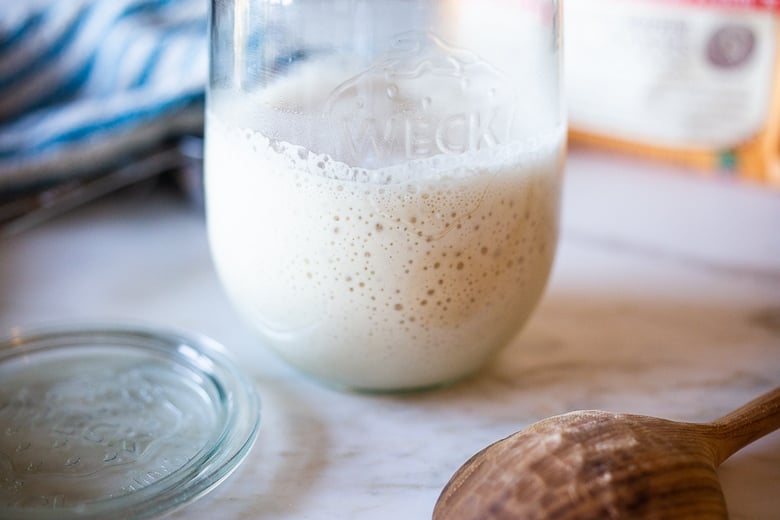
Understand that your starter has a schedule of its own; it is a living thing, so watch it and pay attention.
If your starter is not rising and falling, look at its consistency. As it metabolizes the flour and gets hungry, it will get runny and liquidy, like to the point where you can pour it right out of the jar. If it is still thick like paste, it’s not done metabolizing (eating)the flour.
Day 5: Feed again, 1-2 times, discarding all but a 1/2 cup the starter each time. Adding 1 cup bread flour and 1/2 cup lukewarm water. The starter should look visibly active, bubbling, rising, hopefully, close to doubling in size.
Repeat day 5 until the starter is rising and falling predictably and is close to doubling in size within 6-8 hours.
TIP #4: If your starter is not rising but there is evidence of hunger (liquidy or liquid at the top) try 3 things: substitute 1/4 cup whole grain flour (add to ¾ cup white bread flour) on your next feeding. Try using mineral water like San Pellegrino instead of water. Stir the starter a few times after feeding to allow more wild yeast from the kithcen to get inside.
DAY 6 Morning: Baking day! Give it one last feeding in the morning: this time discard all but a 1/3 cup. (The reason we are changing this to 1/3 cup is to feed it a little bit more.) Add 1 cup flour (120 grams) and 1/2 cup water, stir, and place it in a clean jar so you can see the action clearly. You can use a sharpie or place a rubber band around the jar to mark the beginning level. The starter should hopefully double in volume within 6-8 hours of feeding.
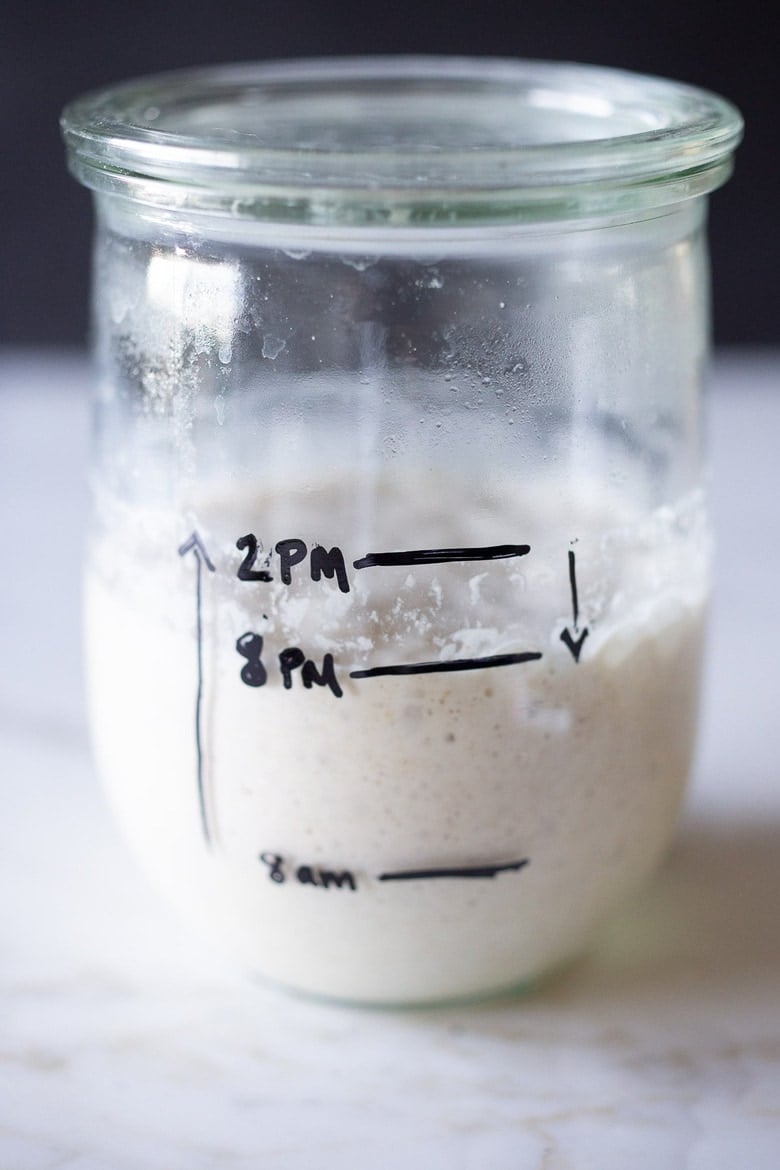
In the photo above, on the 6th day, the starter was fed at 8 am, it peaked around 2 pm, then it started deflating, and by 8 pm, it was “hungry” again. See those downward “slide” marks on the jar?
DO THE FLOAT TEST: When the starter is at its peak, or just after, place a teaspoon of starter (just from the top, don’t stir it down) in a glass full of water; it should hopefully float. If it floats, success!!! Congrats. You can now make our sourdough bread…tonight!
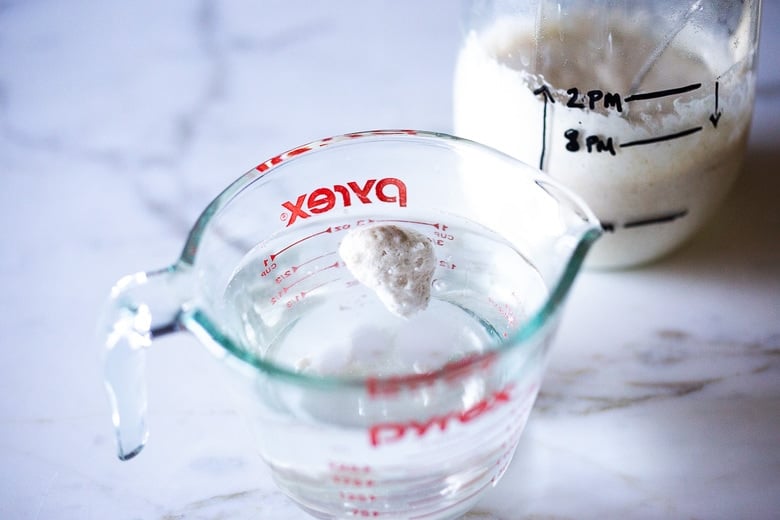
TIP #5: When baking bread always use hungry starter that has already peaked!
STARTER DOES NOT FLOAT? If it doubles in size but does not float, you can still try baking a loaf if it doubles within 6-8 hours of feeding it.
At this point, if your starter does not double in size within 6-8 hours of feeding, don’t give up! Often, it just takes longer, especially during the winter months. Continue feeding one to two times a day until you see a consistent, predictable rise and fall.
Read the troubleshooting section. If you need to take a break, put it in the fridge and try it again up to a week later. Don’t toss it!
Day 6 Evening: Let’s Bake! Use 1/3 cup starter to make this sourdough bread recipe and place the remaining starter (or if not making bread, place all of it) in the refrigerator, and feed it at least once a week, reserving ½ cup starter, before feeding it the usual 1 cup bread flour, 1/2 cup water.
TROUBLESHOOTING Starter
- SMELL: Starter should smell sweet, tangy, earthy, like a wet horse – not “bad”. If it really smells foul or unpleasant, you may have used an unclean jar, unclean utensil, or somehow introduced other bad bacteria. I would start over.
- NO ACTION: On day 4-5 it is typically for it to slow down. If your starter is not rising at all but there is evidence of hunger (liquid at the top, or bubbles) try 3 things. First substitute 1/4 cup whole grain flour (add to ¾ cup white bread flour) on your next feeding. If no rise, then try using mineral water, specifically San Pellegrino instead of water. San Pelligrino specifically has the right mineral ratio, I have great luck with it. Others not so much! Also try stirring the starter a couple of hours after feeding, a couple of times throughout the day to allow wild yeast from the room to get in there. Lastly, you could try pineapple juice instead of water.
- FLOUR: Try to use fresh milled whole grain flour to start, then organic BREAD FLOUR. The more wild yeast in the flour, the better your starter will do- so smaller brands like Bob’s Red Mill seem to do better than bigger conventional brands that have been overly processed. It is totally OK to mix flours and to switch them up- this adds different kinds of wild yeast- a good thing!
- DO NOT overfeed. For example, maybe feeding 2 x day at 12-hour intervals is too often. You want to feed after the starter has peaked, then deflated (see photo above- you’ll see some slide marks on the jar) and this tells you that it is hungry. If you feed the starter before it has had a chance to metabolize (or eat) all the flour (before peaking) and then you discard part of it, and feed it again, you are actually diluting all that amazing bacteria, weakening your starter. So it’s all about watching your starter in your home. If you are not seeing rising and falling, but notice the starter just gets liquidy, this too is a sign of “hunger”. Or if it gets runny enough to pour out of the jar, another sign it is hungry. There are lots of variables here. Just be patient, pay attention and watch. This is a living thing- it doesn’t care about time schedules and recipes or what it “should” do. It will “eat” when it is “hungry” and sometimes it likes to eat slowly. 😉
- TIME: It may take longer than 6 days in colder environments. Use a kitchen thermometer and take its temp. Is it over 65F? Find a place where it can be warm. In the oven with the light on, or in an upper cupboard ( heat rises). Sometimes it takes 12-14 days! Be patient, keep going. If it is doing absolutely nothing, leave it out on the counter for 24-48 hours and see what happens. If you run out of flour or need a break, don’t just toss it, put it in the fridge and see if you can get it going a few days later.
- ACIDITY: If you still can’t get that starter going, some people recommend subbing pineapple juice for the water for one feeding- raising the acidity level. My good friend just tried this and it got hers going.
- LIQUID: If you see any liquid at the top of your starter, it means your starter is hungry. So, yes it’s still alive which is a good thing! You can stir the liquid in, or pour the liquid out, either way, but feed it. This is a sign that you may need to feed it more often.
- MOLD: if you see any discoloring or mold on the surface, starter was probably contaminated. If it is only on the surface, it is probably ok to save. Scrape it off, save 1/2 cup of the underneath starter, and keep going, using a clean jar. Feed, smell, use your best judgment.
- FLOAT TEST: Try testing when your starter is peaking. Take a spoonful from the top without stirring it down. If your starter is rising and falling consistently, but not passing the float test and it has been over 8-10 days- just try baking a loaf. People are having luck with good loaves without passing the float test. It may be the flour…
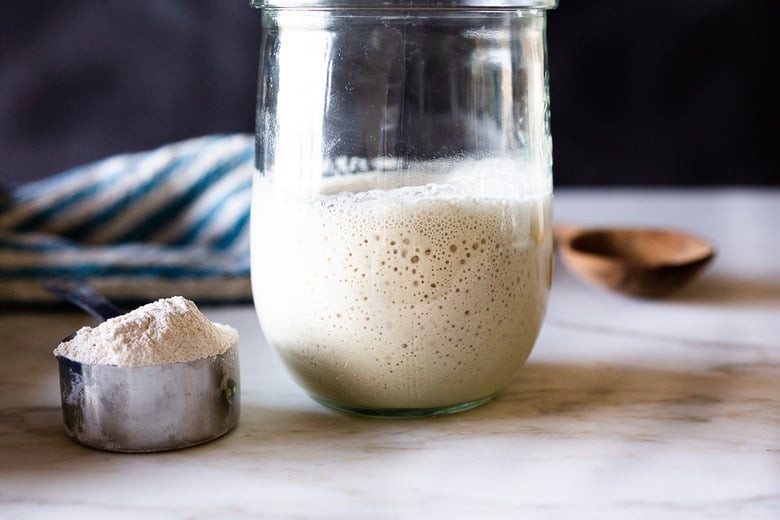
How to Maintain Your Starter
- REFRIGERATE & FEED AT LEAST ONCE A WEEK: Pick a scheduled day and try to stick with it, always reserving 1/2 cup and feeding it 1 cup flour and 1/2 cup water. Discard the remaining, give it away, or keep the discard in a separate container for sourdough pancakes, sourdough buns, banana bread, biscuits, etc. I usually don’t feed the discard unless I give it away.
- If you forget to feed it one week, it is most likely OK; feed it 1-2 times a day for 1-3 days in a row to revive it (keeping it out on the counter) until bubbly and active and doubles within 6 hours. I’ve left my starter for a month on vacation (in the fridge) without feeding and simply revived it by feeding it 3 days in a row, 1-2 x day. It’s surprisingly hard to kill. You can also freeze it for more extended storage.
- This batch will allow you to bake 2 loaves of bread per week with enough left to feed for the next week. If you want to bake more often, you can keep it out and feed it 1-2 x daily. Or if baking every few days, you can pull it out of the fridge, feed it 10 hours before using, leaving it out, use what you need while it is peaking (or slightly after), then put it back in the fridge that evening. Do the same thing a few days later when ready to use again. So this would be feeding 2-3 times a week, best if baking 4-5 times a week.
The best time to use sourdough starter is just after it peaks or on its way down when you know it is hungry.
Sourdough Bread Starter FAQs
Yes. While you are building your starter, during the first week, it is the simplest, easiest, fastest, and most economical way to create a healthy starter. (Or save it separately -in the fridge- and use it in Pancakes, Waffles, Buns, or Biscuits. ) This is because you always have to feed it two times its volume in flour. For example-if you kept all the 1 1/2 cups of starter, you would have to feed it 3 cups of flour (instead of keeping just a 1/2 cup and only feeding it ONE cup). Discarding will shorten the fermentation process, require less flour in the long run, and create a stronger starter. Once your starter is “established” after the first week- then you can give it away to friends, use it in pizza dough, pancakes, etc) or give it to a friend.
How to use your Sourdough Starter
- See all our Sourdough Recipes!
- Sourdough Scones
- Sourdough Crackers
- Sourdough Biscuits
- Sourdough Buns
- Sourdough Tortillas!
- Vegan Banana Bread
- Overnight Sourdough Waffles
More from Feasting At Home
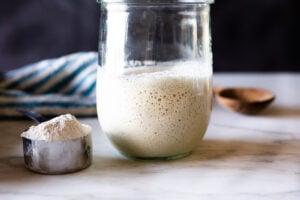
Simple Sourdough Starter
- Prep Time: 30
- Cook Time: 6 days
- Total Time: 144 hours 30 minutes
- Yield: 1 ½ cups
- Category: sourdough, fermented, cultured, bread, baking,
- Method: fermented
- Cuisine: bread
- Diet: Vegan
Description
How to make your own Sourdough Starter (see the step-by-step video in post) using simple ingredients with no special equipment, in 6 days, that can be used in sourdough bread. Sourdough Starter is a wild yeast, made from fermenting flour and water.
Ingredients
- 120 grams whole grain flour (whole wheat flour, rye flour, or freshly milled flour) 1 cup, fluffed, spooned and leveled
- Organic White Bread Flour (5-10 lb bag ) I like Shepherd’s Grain or Bob’s Red Mill.
- 120 grams Water per feeding (1/2 cup water)
Instructions
-
- Day 1: Starting in the morning or at night, using a wide-mouth quart jar or Crock or Glass Measuring Cup mix 1 cup whole grain flour (120 grams) with 1/2 cup (120 grams) filtered water using a fork making sure you’ve incorporated all the dry flour. For your first measuring – it is a good idea to weigh the flour, using a kitchen scale so you get an idea of how thick it should feel. It should be like a thick paste. Thick like peanut butter. If you need to add a little more water to incorporate the flour, that is OK, but be precise with the flour. Place the lid on top (using the Weck jar is really handy here) or a damp towel to keep moisture in, or plastic wrap- and let sit at room temperature (70-80 degrees) on the kitchen counter for 24-48 hours, or until you see some bubbling. If you are not sure how warm it is, use a kitchen thermometer and check it a few hours later. See notes for TEMPERATURE.
- Day 2: After the first 24 hours, you may or may not see a bit of bubbling. I prefer to let this rest until I see a tiny bit of activity (bubbles) and sometimes this takes 36 or up to 48 hours. So start “day 2”, when you see a little bit of bubbing. Discard all but 1/2 cup (136 grams) of the starter. (See notes for discard). Add to the remainder, 1 cup of white bread flour, (120 grams), spooned and leveled, and 1/2 cup filtered water (120 grams), mixing well with a fork. Place the lid on loosely again and allow the mixture to sit at room temperature (70-80F) for another 24 hours.
- Day 3: By the third day, you should definitely see some bubbling- and if not, let it go a bit longer. Depending on how warm your house is and how active your starter, you may need to begin feeding more often, or even move to two feedings a day roughly 12 hours apart, like in the morning and at night. In a nutshell, you want to feed the starter only after it has peaked (metabolized all the flour from the last feeding) and has started sinking down or gets liquidy- this is when it is hungry! This might be 12 hours, it might be 14, it might be 18, or 24, depending on the temp in your house. In very warm climates it may only be 8 hours. It is better to underfeed rather than overfeed here. For each feeding, like before, discard all but 1/2 cup of the STARTER (keeping roughly ½-cup of starter in the jar -4 ounces or 136 grams) Add 1 cup Bread Flour (spooned and leveled) and 1/2 cup water to the 1/2 cup starter and let this rest at room temperature for 12-24 hours or until the starter looks “hungry” again before repeating.
- Day 4: Feed 1-2 times, discarding all but 1/2 cup of starter EACH TIME. Feed 1 cup bread flour, 1/2 cup water. Look for the hunger signs. Hopefully, you’ll begin to see some rising and falling. It’s helpful to put the starter in a clean jar and mark the beginning level (with sharpie, string or rubber band) so you can easily see this. ***If for some reason your starter looks like it is still rising at the time of second feeding (at night) and there is no evidence it has fallen or no slide marks, it is still “eating” so skip this feeding and feed first thing in the morning. AGAIN, Feeding it when it is “not hungry” will basically dilute all the growing yeast and make it lethargic. Better to starve than overfeed.
- Day 5: Feed again, 1-2 times, roughly 12 hours apart, or when hungry, discarding all but a 1/2 cup the starter EACH TIME. 1 cup bread flour, 1/2 cup lukewarm water. The starter should look active, bubbling, rising, sliding down, hopefully, close to doubling in size. (If not, repeat this day until starter doubles in size within 8-12 hours of feeding- and read the troubleshooting section.)
- DAY 6: Give it one last feeding. Discard all but a 1/3 cup. Add 1 cup flour ( 120 grams) and 1/2 cup water, and place it in a clean jar so you can see the action clearly. You can use a sharpie or place a rubber band around the jar to mark the beginning level. The starter should hopefully double in volume within 6 hours of feeding. When it peaks, DO THE FLOAT TEST: To test the starter, place a teaspoon of starter (just from the top, while it is peaking, don’t stir it down) in a glass full of water, it should hopefully float. If it does, you can make sourdough bread. Tonight! Let the starter keep resting at room temperature or a few more hours allowing it to fully metabolize the flour, perhaps sinking a little before making your dough. You want to make dough with slightly hungry starter. Place the remaining starter in the fridge and feed it in a week. You’ll have enough stater to make one more sourdough loaf during the week, and still have enough to feed. If you want to wait to make bread until later in the week place starter in the fridge. Be sure to feed it in 7 days. Read maintenance section.
- At this point, if your starter does not double in size don’t give up! Often it just takes longer, sometimes up to two weeks, especially if it’s cold. Continue feeding one-two times a day (only when hungry) for a few more days, until you see a visible rise and fall. Read the troubleshooting section. If you need to take a break, just put it in the fridge and try it again up to a week later. Don’t toss it- if there are bubbles, it is still alive.
- This batch of starter will make two loaves of bread with enough left over to feed for the following week.
Notes
- TEMPERATURE: The colder your home, the longer it will take for the starter to grow and become active (bubbles). Find a warm spot (70-80 degrees) for the best results. On the stovetop, with the light turned on, or on top of the fridge. Or in the oven with the light on. On top of a heating pad (set to low) with a towel in between). You can still make the starter in a colder home, it will just take longer- even up to 2 weeks.
- FLOUR: Always try to start the batch by using organic, freshly milled whole-grain flour (wheat or rye) because it has more wild yeast in it than All-Purpose or white flour and will get it active and growing sooner. You can, of course, continue to use whole grain, but I’ve had the best luck using organic “bread” flour for days 2 through 6. People have made a sourdough starter with All-Purpose flour- but personally, this has never worked for me– there are fewer nutrients and wild yeasts in the flour and results in a very lethargic starter. If it is your only option, try mixing in 2+ tablespoons of whole-grain (wheat or rye) with the AP flour per feeding. Feel free to use different flours or mix different flours together. It is OK to use all-purpose flour if in a pinch, but using it repeatedly will result in sad starter.
- WATER: I usually use tap water -but sometimes the chlorine in tap water can inhibit the growth of your starter. Lukewarm water helps fermentation to start faster. Sterilized bottled water is often overly sterile, and can also inhibit. Mineral water, like Perrier (carbonated is OK) can sometimes work miracles.
- HYDRATION: Hydration refers to the ratio of water to flour in terms of weight. It is a ratio. The starter is typically at 100% hydration- meaning equal parts flour and water, in terms of weight. So if you use 120 grams of water, use 120 grams of flour. This roughly translates to 1 cup of flour and 1/2 cup water. Feel free to weigh instead of measure if you want to be more precise, or want to familiarize yourself with the consistency you are aiming for. If using whole grain flours (which tend to be “thirstier”) and your starter seems very thick, it is totally OK to add more water to thin it a bit. I intentionally keep the hydration a little lower here (a thicker starter) so you can more clearly see the rise and fall “action” in the jar.
- STORING AND FEEDING: When your starter is kept cold, in the fridge, you don’t need to feed it as often- only once a week. Feel free to feed it “cold”, and put it right back in the fridge if you like. If you keep it out on the counter, you’ll likely need to feed it 1-2 x daily (or just watch and feed only when hungry). Cold slows down the fermentation, heat speeds it up.
- USING: When you need to use your starter for baking bread, feed it 10-12 hours before making bread dough, using it after its peak height. For a more “sour” flavored bread, use the starter straight from the fridge, 3-6 days after feeding. The starter gets more sour tasting the longer it goes without feeding. Feeding the starter the same day as making bread will produce a milder sourdough flavor.
Nutrition
- Serving Size: 1 tablespoon
- Calories: 31
- Sugar: 0 g
- Sodium: 0.2 mg
- Fat: 0.1 g
- Saturated Fat: 0 g
- Trans Fat:
- Carbohydrates: 6.2 g
- Fiber: 0.2 g
- Protein: 1 g
- Cholesterol: 0 mg
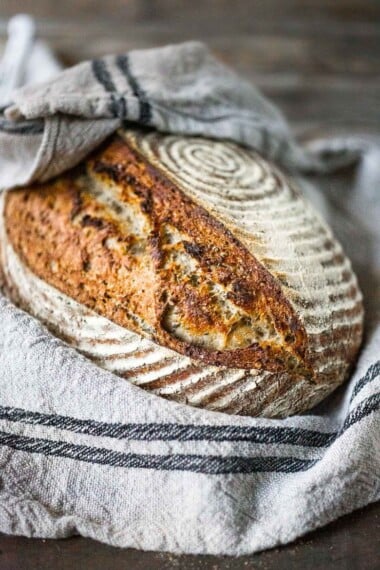

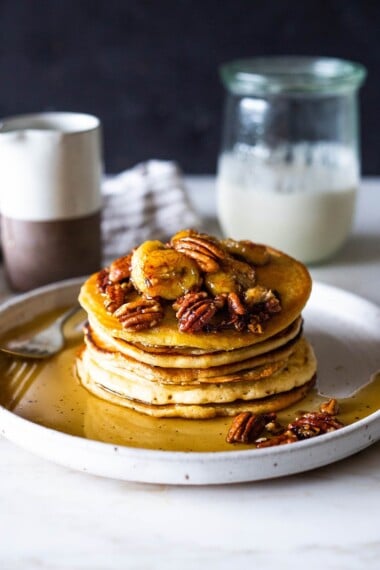
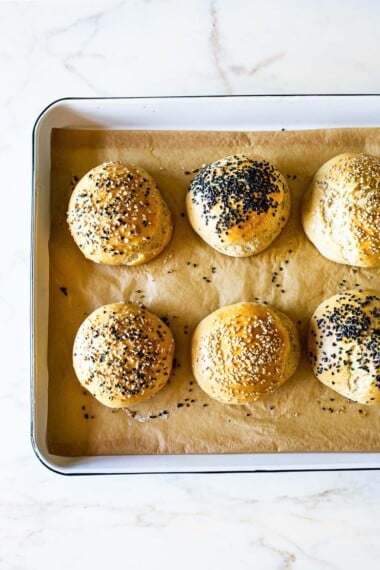







I used this recipe for my starter that I have kept for about a month. It has now started to smell like alcohol. I read that you should increase feedings to clear this up, but will that dilute the strength of the starter?
Thanks!
I would feed once a week, and keep in the fridge. It will not dilute if discarding.
Hi Syliva,
As many others have noted…thank you so much for your detailed instructions. I successfully made a starter and several loaves of bread back home in Chicago. I’m currently trying to replicate the process out on the west coast now and I’m not having the same luck. I’m hoping to email you what I’ve been doing and seek your guidance (I’ve read LOTS of comments here and having no luck).
I’d greatly appreciate your thoughts!
I just responded to your email. 🙂
Hey thanks for this! so clear!
was just wondering if using white spelt organic flour is also ok?
thanks again:)
Hey thanks for this!
was just wondering if i could instead use white spelt organic flour?
thanks again:)
It should be fine!
Thanks you’re amazing!
I’m currently on day 2, a few hours after I’ve discarded and fed the starter, and I’ve just seen that the starter has trippled in size it is currently at the tip of the jar about to spill over is this normal?
help!
It is great- just means it’s happy and alive.
Hey 🙂
Thanks for responding each time you’re the best!
So I need a little help… Until the evening of day 3 my starter was doing great bubbling, peaking and sliding etc.. Since last night (night of day 3) it’s been rather flat and hasn’t risen or slid down at all. I tried changing the feeds to wholewheat spelt and still nothing 🙁
Have I killed it? There are a few bubbles on the surface but no where near to how bubbly and frothy it was at the end of day 2 🙁
How often should i be feeding if it doesn’t seem to rise?
Thanks for all
Thanks Hannah! Reread the troubleshooting section. I would delay feeding until you know it is extra hungry. If there are bubbles it is not dead. 🙂 Just keep going.
Hi
Thanks for being so patient! Im just wondering if I should throw this starter out and make a new one. Its remained deflated not risen or showed any signs for the last 3 days whatever I do. I read the troubleshooting section and changed to wholegrain but nothing helps:( The first 2 days it was great and now its not.
Thanks for all!
Oh no. I hate to have you through it out- but if you see no action what so ever, then maybe??
Hi! I am almost 12 hours into day 1. I am noticing condensation at the top of my jars (I made three just in case something goes wrong). I don’t have lids on super tight but they are mainly blocking air. Any tips?
Sounds good…condensation is fine. 🙂 just keep going.
Thank you! Today is day 3 and I got a lot of good rise and fall Within a couple of hours yesterday. It looked bubbly and there were marks. I fed it 90 minutes early today but I noticed that some of the starter was soupy. I do have some thickness but the last couple of day it’s was super thick and now there are some runny parts. I did not include that in the new feed but I wonder what that is a sign of.
Soupy or runny starter, just means it is hungry and metabolized all the flour and is ready for more. This is not a bad thing, it just got hungrier faster. Maybe it was warmer last night?
Thank you for the information you have on your video; no one else has said what you do in explaining amounts used each time. One other lady did say to always use the 1:1:1 ratio but didn’t explain the dividing, etc., etc.
From day one I do not get the fermenting action you do after day one two or three, even with dividing as you do and feeding. I am measuring precisely by weight and waiting. After a week of trying 3 different times my patience is quickly coming to an end!
What am I missing? Please help.
So you are getting no action at all? What flour are you using?
Hi Sylvia! Currently on day 4 and it seems like it’s not ‘hungry’ yet so I will probably only feed it once today. The first day, it smelled really nice but after that there’s an odd smell to it. I tried to compare it to nail polish remover to see if it is acetic acid, and it is similar but not quite. I’m wondering if that is alright? I see lots of activity and whenever I feed it, the smell goes away until next time I open it up
I think the smell is the fermenting smell. It should be ok??
I have this issue every time, as well. It’s like an acetone smell, sometimes very strong as if it’s nail polish remover.
Thank you Sylvia!! These instructions are awesome + the videos really helped. I found them so easy to follow and I had great success making my starter from scratch the first time around! I just have a couple questions about storing the starter in the fridge. If I take some out and use it to bake bread, should I always feed the starter at the same time (even if it’s only been a few days since the last feeding? When feeding it after it has become healthy and active do I still follow the same feeding ratios – 1/2 cup starter + 1/2 cup water + 1 cup flour?
Lastly, I would love some recipes for using the starter discard – I tried just adding the discard to pancake mix and also making muffins with it, but both turned out dense, like they had not risen at all (despite the baking soda I added according to the recipes). Any tips or recipes for using the discard?
Thanks so much!!
I like to use discard that is relatively fresh for recipes like pancakes, muffins. Like use what you discard when feeding on day 7. That hungry discard will create loft in recipes. If you take some starter and use it on day 3 after feeding, NO you don’t have to feed the remaining, you can feed it on day seven. Just feed it once a week if storing in the fridge and baking 1-2 loaves a week. Yes, always follow the same ratios with flour and water.
Thank you! You’re definitely a keeper. I’ve bookmarked this site. 👍🤗👌🏻
Hi! If I want to maintain my starter, do I feed it and immediately put in the fridge or wait until it has peaked and then refrigerate it?
Put it in immediately.
Please help. I used organic Einkorn flour from Italy. The starter is moving along by day three I have just completed the third feeding. See bubbles and liquid, but it smells cheesy. Is it because oft the type of flour? I keep it in a large glass bowl on mt counter top covered in cellophane tightly and wash the bowl each time I discard the starter. Should I throw this out. I do not see mold.
Thank you
It sounds like it is doing fine!
I made a COVID starter in May with all purpose. I’m on day 4 with a starter of freshly milled winter wheat sifted flour. I had a doubling on the 2nd and 3rd day, but he second feeding on the 3rd day showed very little activity. Is the yeast activity at the start just going nuts and now it’s survival of the fittest? Seems normal, not as strong bacteria smell.
Perhaps? Maybe let it get a bit hungrier before the next feeding.
Thanks! I ended up keeping with one feeding per day as the rise just seemed delayed. Day 7 came the yeast explosion and.now have a more robust starter than before. Thanks for your help!!
your starter recipe and sourdough bread recipe helped me immensely make a bread for the very first time. Great instructions, especially for the starter dough. Thank you! I do have to say your video for making the sourdough bread, was constantly getting interrupted by ads, and I was hardly able to watch the video in its entirety, without getting interrupted by ads every few seconds. I did not have this problem with your starter video.
Sorry. about that. That is annoying- I will take a look.
So this is probably a dumb question but under the troubleshooting:
If it smells like vomit / bile would you toss it and start over? (it’s day “3” or so and yester-afternoon it bubbled over… could be that a contaminant travelled from the counter / exterior side of the jar back into the main compartment..?
Thank you in Phoenix,
Nathan
That sounds bad. I would toss it, perhaps since this is so early on? Better now than a week later. Make sure your jar and mixing tools are really clean. 🙂
Well. Regardless of the “other” info I asked about from Reddit the batch stopped growing altogether after removing all but 0.5 cups of the “ominous” vomit smelling contents.
So. I’ve scrapped it. Will try again at another time Lord willing. Right now I’m wont to head to Trader Joe’s for some of their bread lol. Shameless plug lol. They have pretty solid sourdough =)
Sorry the info came through in a really odd way- hard to decipher. Regardless, I think start over? I should have a sour smell, like a fermenting smell, but more than that maybe it’s not right.
Thank you for providing such detailed instructions including tips and tricks. Many websites use complex terminology which for the beginner is hard to grasp at times but your instructions provide really clear examples of when to feed the starter. I did not realise I could use discarded starter in other recipes so I am going to try that out too. Loving this page, will return to it regularly!
First I tried making the starter. At about 5 PM Pacific time I BLENDED 120 GRAMS OF WATER AND THE SAME OF DARK RYE FLOUR from our local Bulk Barn. Added 43 grams more water and now 23 hours later it has more than doubled. The dark rye seems to be an exceptional source. May not need 6 days.
Regards;
Jim
Great to hear. It does get more flavorful and complex and more consistant with time. I suggest going the full 6 days. 🙂
I followed your steps. When it seemed lethargic, using a little pineapple juice as the water really helped. I am still a little confused on using the starter. I removed enough to make bread. Took 1/2 cup of the starter, with 1/2 cup water and 1 cup flour to feed it. Put it in the fridge for a week. I am now ready to make bread, do I take it out and let it rise, then fall, then take enough of the starter to make bread, or do I take the starter to make bread when it is cold right out of the fridge?
My first loaf was wonderful, just not sure what to do now to make it again.
Thanks in advance! Marilyn
Take it cold right out of the fridge and use for dough. Then discard all but 1/3 cup and feed this and put back in the fridge for the week.
I followed your steps. When it seemed lethargic, using a little pineapple juice as the water really helped. I am still a little confused on using the starter. I removed enough to make bread. Took 1/2 cup of the starter, with 1/2 cup water and 1 cup flour to feed it. Put it in the fridge for a week. I am now ready to make bread, do I take it out and let it rise, then fall, then take enough of the starter to make bread, or do I take the starter to make bread when it is cold right out of the fridge?
My first loaf was wonderful, just not sure what to do now to make it again.
Thanks in advance! Marilyn
I have been struggling with my attempts at making a starter am on day four of your recipe. I have been following the feeding schedule and ingredients and only feeding when hungry. I started with whole wheat flour and then went to bread flour. My consistent issue with starter is I will feed it, and the only activity shown is some bubbling on top, but it never seems to grow at all. And I quickly end up with some slight hooch on top. But since it is not really growing, just barely bubbling on top, I’m afraid to feed it. When I put it in the oven with the light on, it doesn’t seem to help much. What should I do?
Hi Henrietta, you’ll get it, just be patient. What is the temp in your house if you were to leave it out? Just curious, if maybe the oven is too warm? What are you feeding it? How often? How soon does the hootch show up?
Thank you thank you ! I’m desperate to make sourdough , everyone says “ it’s so simple “ which is maddening when patently its not for me. I try, I give up. Having just bought yet another book on sourdough from yet another sourdough expert I was starting to see the light with a starter that looked and smelled great – BUT aside from beginning to worry about where I would be storing endless bubbling jars for the rest of my life ( why didn’t they just say the magic word DISCARD ?) I realised the hands-on time they were suggesting was literally going to take up half my day . To make one loaf. Cue google search and your fantastic tutorial – all the answers I needed and you have explained it brilliantly. Can’t wait to get going again !
Thanks Jane! I hope this works for you! Give it a couple of tries before you give up. You are almost there!
thank you
So this is the second time I’m attempting this. The first time, the second day it overflowed my jar like a bad science experiment and then the third day it did nothing. Same thing happened on the second day but on the third day I had a slight rise. I’m on the fourth day in there seems to be little to no action. I used whole wheat flour to begin the starter and bread flour every day sense. Am I doing this properly?
Yes, you are doing it fine. You could try adding a little whole wheat at your next feeding ( like 1/4 cup wheat with 3/4 cup bread flour), waiting until the starter is very hungry.
Hi,
I have been following the recipe and it works really well in the first three days. Since the fourth day, autumn hits us hard and the weather dropped significantly. It is only 15-17 Celsius degree daytime and colder during the night. It has been two days but my starter does not seem to rise or hungry at all so I have not fed it more. I put it in the oven with only light on last night. The bubbles look smaller and it seems to be runnier in the morning, nothing else.
I don’t know what to do next or if it can still be saved.
Thank you in advance for your guidance.
Hi, as long as you see activity it can be saved and is alive. The cooler weather is just slowing it down. Keep going with the process, only feeding when hungry. If it’s not rising or falling, you’ll know if it’s hungry if it is runny enough to pour out of the jar. Mine is taking longer to metabolize lately too- from the cooler weather. Just be patient.
Mine seems pretty runny so I fed it again. Finger crossed.
I only found your blog recently but have already tried four recipes and saved many for later. We have really enjoyed them so far.
Thank you for your work and response.
Thanks so much!
Very clear and concise, thank you.
The best I have seen and I have read a few!
Peter
Thanks so much and happy this worked for you!
Hi, if 2nd day, I saw it grow double, can I stir it so it won’t overflow out of the container but no feeding?
Yes, feel free to stir